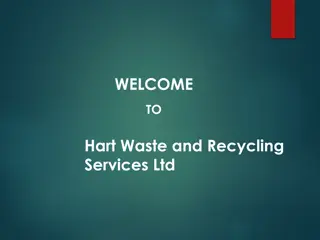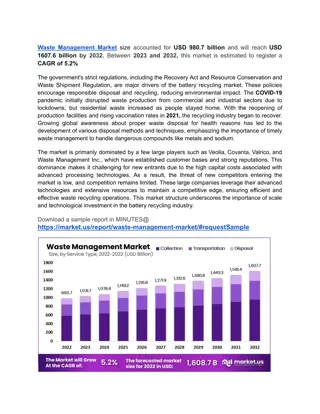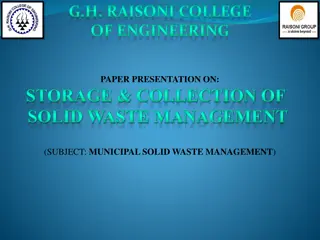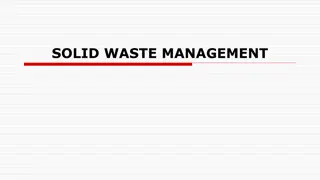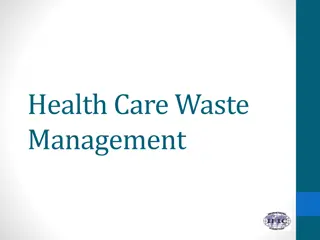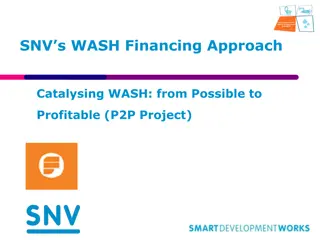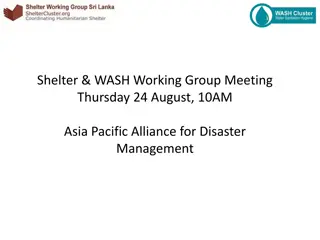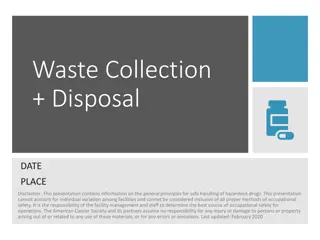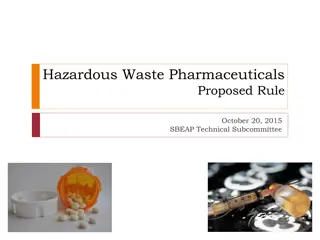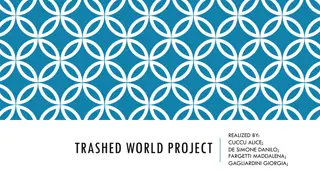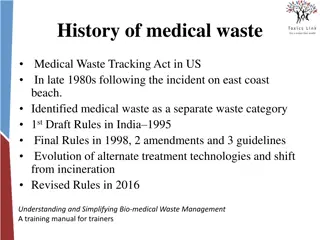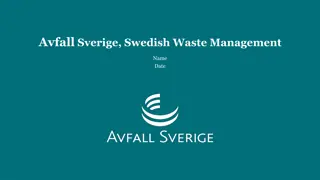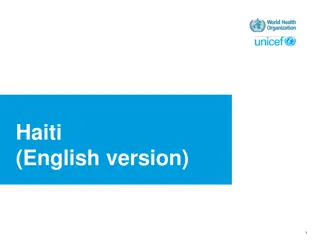Integrated Healthcare Waste Management and WASH in Healthcare Facilities
National Workshop on Integrated Healthcare Waste Management (IHCWM) and Water Sanitation & Hygiene (WASH) in Healthcare Facilities highlighted the importance of following national standards, guidelines, and strategies for effective management of healthcare waste and ensuring proper water, sanitation, and hygiene practices in healthcare settings. The presentation outlined draft documents including national standards for WASH in Healthcare Facilities, healthcare waste management guidelines, and strategies. Steps were taken like forming a Technical Working Group, consulting with stakeholders, and finalizing the standards for endorsement. The risks and preventive measures associated with WASH in healthcare facilities were also discussed, emphasizing the importance of proper protocols to prevent disease transmission and ensure the safety of patients and healthcare infrastructure.
Download Presentation

Please find below an Image/Link to download the presentation.
The content on the website is provided AS IS for your information and personal use only. It may not be sold, licensed, or shared on other websites without obtaining consent from the author. Download presentation by click this link. If you encounter any issues during the download, it is possible that the publisher has removed the file from their server.
E N D
Presentation Transcript
National Workshop on Integrated Healthcare Waste Management (IHCWM) and Water Sanitation & Hygiene (WASH) in Healthcare Facilities National standards, guidelines and strategy IHCWM and WASH in healthcare facilities Chudamani Bhandari Chief of Environmental Health and Healthcare Waste Management Section, Management Division, DoHS
Presentation Outline ( Draft Documents) National Standards for Water, Sanitation and Hygiene (WASH) in HCFs Healthcare Waste Management Guideline Healthcare Waste Management Strategy 12/11/2019 National guidelines and strategy - Chudamani Bhandari 2
National Standards for Water, Sanitation and Hygiene (WASH) in HCFs 12/11/2019 National guidelines and strategy - Chudamani Bhandari 3
Steps followed TWG formed for WASH in HCFs Draft prepared by consultant and task team Consultation meeting at local and federal level Multi stakehoders workshop to collect inputs in draft standards Finalization by TWG Submitted to MD/ DoHS for endorsement process. 12/11/2019 National guidelines and strategy - Chudamani Bhandari 4
WASH in HCFs- Risks & preventive measures Disease risk Airborne infections (e.g. Legionella, avian influenza, SARS, tuberculosis) Prevention measures Ventilation; Space available per patient; Spacing of beds; Use of separate rooms for highly vulnerable or infectious patients; Use of masks and correct incineration of wastes; Isolation of active infection; Proper disposal of sputum; Hand hygiene Water-, food- or handborne infections (e.g. HEV, diarrhoea) Water supply (quality and access); Excreta disposal; Hygiene facilities; Food hygiene; Hand hygiene Infection of wounds/surgical incisions from contaminated water, medical devices and dressings (e.g. sepsis) Use of single-use medical devices and dressings; Pre-disinfection; Cleaning and sterilization of instruments and dressings; Good-quality water; Asepsis in surgical or dressings procedures; Timely sterilization/ Fumigation of OT/ Surgical sites/ beds; Separate exit routes for waste Bloodborne infections due to contaminated needles and syringes, unsafe blood transfusion (e.g. HBV, HCV, HIV) Health-care waste management and use of single-use needles and syringes; Safe blood transfusion Manage needle properly, Do not recap; Use of PPE Heat- and cold-related stress and discomfort (e.g. higher fever) Heating, ventilation, air-conditioning (HVAC) and insulation Vector-borne disease transmission (e.g. malaria, dengue, leishmaniasis) Control of disease vectors in and around buildings; Protection of patients Protection of infrastructure
S. No Category of health facility Federal Health Science Academy 1 Large HCFs Specialized and Super Specialty Hospital 2 Tertiary Hospital 3 Secondary B Hospital 4 Secondary A Hospital 5 Medium HCFs Primary Hospital 6 Primary Health Center 7 8 Health Post Small HCFs 9 Basic Health Services Center 10 Outreach, emergency and mobile camps
Federal Health System (Structure at present) - 2018 Province (7) Local (753) Federal MHU MoSD Autonomous bodies NHRC, MoHP Acidemias, councils, HIB DCC District Dprt. DA PPME Div Hospital (<15B) Health Directorate Health Division Dprt. AA QAR Div Primary Hospital (<15B) / PHCC/UHPC HS Dprt. HC Div CS Div Prov. PHO at each district Health Post HFOMC PM Div Mgt Div CHU, UHC Prov. /Reg. Medical Store Admin Div FW Div PHC/ORC/ EPI Clinic Prov. District Hospital (>15B), ZH, RH EDC Div Specialized Hospitals FCHVs/ MGs NSS Div 32.2 % of Total budget of MoHPfor FY 2018/19 FAA - 39 FAA - 40 7.4 % of Total budget of MoHPfor FY 2018/19 60.4 % of Total budget of MoHPfor FY 2018/19 FAA- 26
Service delivery networks at present HI BHS Public Hospital = 95 Specialized = 19 Central = 11 Teaching = 4 Specialized, central and teaching hospital Federal Private/ non public (community) = 44 District hospital= 52 Zonal Hospital= 10 Regional hospital= 5 Sub Regional hospital= 3 District, Zonal, Regional, Sub regional Hospital Province PHCC= 97 PHCC= 200 Primary Health Care Center (PHCC) Local HP = 3,809 UHC = 250 CHU = 211 PHCORC= 12,180 EPI = 16,022 FCHV = 49,001 Health post, Community health unit, Urban Health Center/Urban Health Promotion Center, PHC/ORC, EPI, FCHV BHSP from Private ?
WASH standards for different type of Healthcare facilities Type of HCFs Water Large HCF Medium Small Outreach Mobile/ Emergency Sanitation A A B B B Hygiene A A A B B HCWM A A A B Mobile/temporary HCF may vary, depending upon the services provided. Hence, HCWM is applicable as per the service provided in the specified category of the HCF, for example if the temporary HF provides secondary hospital level service then HCWM standard should comply the same level. A A A B B Notes: A = Advanced ( A ). We have A standrad for Water as per national standard. Advance standard followed as per WHO guideline. B=Basic, For sanitation, hygiene and HCWM indicators are suggested in details
Service Level Service level Health Facilities Advanced To meet all the requirement as defined at WASH standard for advanced level (A I and AII as per the standards ladder) Improved toilets are usable, separated for patients and staff, separated for women and allowing menstrual hygiene management, and meet the needs of people with limited mobility Water in Sanitation in Health Facilities Hand Hygiene in Health Facilities Waste Management in Health Facilities Hand hygiene materials, either a basin with water and soap or alcohol hand rub, are available at points of care and toilets Waste is safely segregated into at least three bins in the consultation area and sharps and infectious wastes are treated and disposed of safely Water from an improved source is availableon premises Basic
Healthcare Waste Management Guideline 12/11/2019 National guidelines and strategy - Chudamani Bhandari 11
HCWM Guideline Guiding Principal Existing National Acts, Rules and Regulation related to HCWM The constitution of Nepal (2015) Public Health Act 2075 Local Governance Operation Act 2074 Solid waste management Act 2011 International Agreements and Underlying Legislative and Regulatory Principles Update of existing HCWM Guideline 2014
Objective of HCWM guideline Protection public health by reducing the exposure of employees, patients, attendants, and entire community to hazardous HCWs Safeguard environment protection through waste minimization and promotion of environment friendly technology for safe disposal Facilitate federal, provincial, local government and health care facilities regarding implementation of proper health care waste management system. Facilitate compliance with Minimum Service Standard of HFs and standard for WASH in HCFs, renew operate guideline, guideline for health institutions establishment, operation and upgrade standard. Reduce possible risk through better waste handling; improving infection prevention practices within the health care facility. Facilitate health facility to select best environment friendly treatment and disposal option based on best available option in country context. 12/11/2019 National guidelines and strategy - Chudamani Bhandari 13
Scope of revised HCWM guideline To support federal, provincial, local government and all level of health care facilities for implementation of safe health care waste management system. Adopt best available technology in country context. The target audience of the guideline are national authorities involved with health care waste management, health care practitioners at all level, waste management service providers; public health professionals private sector, veterinary, NGO, INGO, CBO, clinic, health camp, sessions and other relevant stakeholders and individuals involved in health care waste management. 12/11/2019 National guidelines and strategy - Chudamani Bhandari 14
Steps followed Formation of Technical Working Group Director, Management Division/ DHS Chief of Env. Health and HCWM section/ MD Representative of Ministry of forest and environment Representative of GIZ-S2HSP Representative of WHO Representative of KfW / M4H Representative of UNDP MuAN Developed the ToR of TWG Formed task team to prepare the draft of revised guideline TWG meeting to finalized the draft of HCWM guideline Preliminary draft is ready for final discussion - Chair -Member secretary -Member -Member -Member -Member -Member - Member 12/11/2019 National guidelines and strategy - Chudamani Bhandari 15
Contents in revised version Updated according to recent policies, acts and regulations Governance and management structures are revised according to local, province and federal government s functions and structure. HCWM Standards are redefined and considered based on new technology and practices Technical guidelines, HCWM standard, SoP will be considered as new features 12/11/2019 National guidelines and strategy - Chudamani Bhandari 16
What is in new Guideline ? Updated areas in revised Healthcare waste management - steering structure of local government and facility level with implementation model - More options of non burn technologies for treatment of healthcare waste like microwave, autoclave - Elaborated treatment and disposal techniques of pharmaceutical waste, chemical waste, radioactive waste - Added standard for healthcare waste management at different level of facility level Highlights No burn any waste Types of Waste Technology Healthcare Waste disposal in Scale(Small,Medium,Large) Sectoral responsibility Level wise responsibility- Federal, Province, Local Integrated approach 12/11/2019 National guidelines and strategy - Chudamani Bhandari 17
Next Steps Incorporate suggestions recommendations Core team meeting TWG meeting Extended TWG meeting Final Approval & Endorsement 12/11/2019 National guidelines and strategy - Chudamani Bhandari 18
Integrated Health Care Waste Management (IHCWM) at Sub-National Level: A strategic framework for multi-sectoral cooperation in Nepal 12/11/2019 National guidelines and strategy - Chudamani Bhandari 19
Objective of the HCWM Strategy to set targets and timetables for implementation of HCWM guidelines and establish modalities for ensuring the creation and sustaining of the human, infrastructural, and economic resources for carrying out and completing all of the necessary work to guide newly established local and provincial governments in protecting their citizens and the Nepali environment. is to provide framework for actions to implement safe health care waste management systems at health care facilities of local, provincial and federal level. to ensure that all health-care facilities in Nepal have safe, functional and sustainable health care waste management system that inflicts no harm to public and environment.
Steps followed TWG formed at local, province and central level(same TWG for HCWM Guideline) Draft Concept and ToR process National and International expert consultant hired. Diagnostic Assessment of local and provincial HCFs Technical feasibility of HCWM Multi stakeholders consultation meeting and workshops at municipality level, province level. TWG meeting on draft strategy First draft is ready 12/11/2019 National guidelines and strategy - Chudamani Bhandari 21
Six Strategic Priorities (Proposed) 1. Strengthen policies, guidelines, regulations and standards 2. Ensure adequate resources 3. Improve infrastructure and equipment supply 4. Increase awareness, advocacy and capacity 5. Develop and implement health care waste management system 6. Strengthen monitoring, evaluation and enforcement 12/11/2019 National guidelines and strategy - Chudamani Bhandari 22
Strategic framework Federal Level OUTPUTS: Healthcare waste management guideline and standards are updated. Develop healthcare waste management Training reference book Enhance monitoring, reward and evaluation. Federal Health institution and government budgets include a separate line item for waste management Procurement specifications for equipment are developed, adopted and followed by Logistic management Section Environment friendly and Non-burning technology has been encouraged and adopted for waste treatment and management. 12/11/2019 National guidelines and strategy - Chudamani Bhandari 23
Strategic framework Provincial Level OUTPUTS: Environment friendly and Non-burning technology has been encouraged and adopted for waste treatment and management. Training center established at Provincial levels to supports capacity building at the local level. Integrated Healthcare Waste Management system model is demonstrated and agreed by local and provincial government. Provincial government has allocated investment funds to implement HCWM. 12/11/2019 National guidelines and strategy - Chudamani Bhandari 24
Strategic framework Local Level OUTPUTS: Local level Strategic plan on HCWM is developed and disseminated Updated legal frameworks for the implementation of HCWM at local level Local government allocate separate line item budget for healthcare waste management Integrated HCWM business model developed for local level healthcare facilities. Environment friendly and Non-burning technology has been encouraged and adopted for waste treatment and management. 12/11/2019 National guidelines and strategy - Chudamani Bhandari 25
1. Strengthen policies, guidelines, regulations and standards Objective 1a: Strengthen policy and regulatory structures and mechanisms for HCWM Most of Nepal s policy on waste management will be dictated at the federal level, and this will in turn be related to the international agreements to which the federal Government is a party (eg. The Stockholm and Minamata Conventions), but there will also be policy decisions made at provincial, local and facility levels. Strategic intervention, activities and output Strategic intervention Create a legally binding strategic plan Activities Create a Technical Working Group comprised of stakeholders and experts Encourage environmentally-preferable non-burn technologies Develop a HCWM policy Update existing HCWM national guidelines, Standard Operating Procedure (SOP), standards, and legal frameworks, as per the new policy Update organizational structures and governance roles as per the new policy National guidelines and strategy - Chudamani Bhandari 26
Expected Outputs HCWM policy at the federal level has been developed and disseminated HCWM national guidelines, SOP and standards have been updated Federal level legal frameworks (Acts & Regulations) for the implementation of HCWM have been updated (under the jurisdiction of MoHP and MoFE) Integrated organizational structures with governance roles have been established 12/11/2019 National guidelines and strategy - Chudamani Bhandari 27
Next Steps Incorporate suggestions recommendations Core team meeting TWG meeting Extended TWG meeting Final Approval & Endorsement 12/11/2019 National guidelines and strategy - Chudamani Bhandari 28
() ( , , , ) , , , ( M , ) M , ( %) / / M , ( %) . ., / / ? Pressurized container Waste with high content of heavy metals Other hazardous chemical waste ? / /
(Proposed Governance Structure) ( , , ) Health Facilities (Public, Private, Community) :jf:Yo MOHP , (TWG for IHCWM at Federal Level) (Federal Government) HOMC , , , . , . . (TWG for IHCWM at Federal Level) (Provincial Government) Ministry of Social Development (MOSD) Far West Province HOMC , . . , . , . , , , , (TWG for IHCWM at Local Level) Municipalities (Local Government) HFOMC
Next Steps Incorporate suggestions recommendations Core team meeting TWG meeting Extended TWG meeting Final Approval & Endorsement 12/11/2019 National guidelines and strategy - Chudamani Bhandari 31
THANK YOU 12/11/2019 National guidelines and strategy - Chudamani Bhandari 32


